
No one likes to have the sense of abandoning their parents or grandparents. And for older individuals, the idea of leaving the security of home can be daunting. But a care home really is sometimes the best and most reasonable solution.
But the decision should not be rushed. In states like Florida, Sunrise home health care is a great alternative that allows elderly patients the chance to stay in their comfort zones despite receiving help. But what if even home care is not enough?
Let us talk about the signs, alternatives, and what to watch out for.
When Safety Is a Daily Issue
Safety is one of the biggest reasons that individuals enter care homes. If your loved one is falling all the time, wandering, or forgetting to turn off the stove, that’s a big red flag. You can’t be there 24/7. And that’s okay.
There comes a point when even the best, wonderful family caregiver can’t prevent accidents from occurring. If your loved one’s home has turned into a hazard zone, it’s time to confront the difficult question: Can they really live here safely anymore?
They Need More Medical Help Than You Can Give
Others come to a place where their medical requirements become too complex. Whatever the case, Alzheimer’s, dementia, Parkinson’s, or mobility, managing medications, watching for symptoms, and reacting to crises becomes a full-time job.
Home care can help up to a point. From bathing to dressing, medication reminders, or meal preparation, any Sunrise home health care services will provide a lot of assistance. But whenever your dear one requires 24-hour medical care or frequent hospital visits, a care home is better suited.
You’re Burning Out as a Caregiver
Caring for an aging parent is a part-time job—a job that will wear you out in a hurry. It’s not simply a question of cooking or chauffeuring. It’s psychological. Ever-present worry, sleepless nights, and lost work time can all gnaw at you.
Being restless, exhausted, or quick to temper could be red flags to seek help. Just remember that caring for personal mental health is not selfish. It’s necessary. You can’t give out of an empty cup.
Daily Habits Are Being Neglected
Has your loved one given up showering daily? Re-wearing clothes for days? Losing weight as they forget to eat or won’t cook? That’s not just forgetfulness—it’s often a sign that they’re struggling to keep up.
All persons are entitled to age with dignity. And that means having someone to lean on when daily routines become too much to do alone.
They’re Alone And Unhappy
Loneliness is truly as fatal as any illness. An older individual living alone with very little going out is prone to depression, cognitive decline, and health deterioration. If your loved one spends most of the time alone, you may begin to consider other options.
A care home will provide companionship, activities, and human interaction—things which help to reinstate the joy of living for the elderly.
But Is a Care Home the Only Solution?
No.
Sometimes what your loved one really needs is extra help at home. That’s where Sunrise home health care comes into the picture. Through home care services, your grandparent or parent may be able to stay home but still receive help with:
- Companionship
- Household chores and meals
- Rides to doctor appointments
- Bathing, getting dressed, and grooming
This is a consideration when they are still very independent but possibly need help during the day.
How to Have This with Your Loved One
No one likes to lose autonomy. That’s why this is an emotional conversation. Here are a few suggestions:
- Don’t surprise them. Ask them about it kindly, over time.
- Ask open-ended questions. “How have you been feeling lately?” or “What’s been hardest about your day?”
- Involve them in the decision. Make them have some say.
- Take your time. It may take a few discussions before they realize.

Wisdom Senior Care Can Help
If you are still not sure which way is best—home or care facility—do not worry, we can help.
With Wisdom Senior Care, we provide safe and reliable home care services that enable aging in place and become available. We offer:
- Companionship to prevent loneliness
- Transportation for shopping and appointments
- Home management, such as doing laundry, cleaning, and organizing
- Gentle, respectful personal care assistance
Whether your loved one needs a few hours of assistance a day or more frequent care, we work with families to create an appropriate plan. A little bit of assistance can make a big difference.
FAQs About Elder Care Options
- Can a senior temporarily move into a care home?
Yes. A few care homes offer respite or short stays. This might give families some relief or allow older adults to recover from illness or surgery.
- How is assisted living distinct from a nursing home?
Assisted living offers help with daily activities but is not medical in nature. Nursing homes provide more intense medical care and supervision.
- Will Medicare pay for the cost of a care home?
Medicare does not typically cover long-term care facilities, but it might cover short-term stays or rehab. Medicaid and long-term care insurance are definitely options to consider.
- Is it best to bring an elderly parent in with the family?
It depends. For some families, it is a wonderful solution. For others, it leads to tension, stress, or burnout. Consider your home space, your schedule, and your capacity to provide for their needs before making a decision.
Final Thoughts
It’s never simple to make the decision when to move a senior into a care home. Safety, health, happiness, and money – you have to weigh all of these. But you don’t have to weigh them by yourself.
Start out by discovering the possibilities offered by home health care. It may be everything your loved one is getting now.
And if you’re in the Fort Lauderdale area, senior home care Plantation FL families trust is just a call away. Reach out to Wisdom Senior Care today, and let’s find the best solution together.

No one thinks it is an easy decision to make when considering a care home for a loved one. It is something that is gut-wrenchingly difficult. Nonetheless, at some point, the question must be asked: When?
With home health care Plantation FL, options now allow seniors to remain in their homes longer, even though, at some point, remaining at home is just not safe or practical with or without assistance.
So, when does it really start crossing that line for you? Let’s figure that out.
Signs It May Be Time for a Care Home
There is no universal answer to this question. Every situation is unique. But here are a few common indicators it’s time to consider a care home:
1. Safety Is a Daily Concern
If your loved one is constantly falling, forgetting to turn off the stove, and neglecting to lock the doors, that is a serious thought. Safety always comes first.
2. Severe Medical Conditions
Chronic ill patients with Alzheimer’s disease, Parkinson’s disease, or end-stage heart disease need care beyond what is feasible or safe in a house, more so if mobility is compromised or if they need continuous attention.
3. Family Caregiver Burnout
Members of a family taking on the burden of caregiving for their loved ones often do so because of love. Love may turn into physical and emotional exhaustion. At some point, the caregivers may start feeling overburdened or getting sick themselves. That is when they need some assistance.
4. Personal Hygiene and Nutrition Are Slipping Away
Dirty hair, wearing the same clothes for several days, losing weight—these are signs your loved one may not be handling daily activities. It’s not so much a case of being clean—it’s a case of dignity and health.
5. Isolation and Depression
Without companionship, older adults can get lonely or overlooked. That isolation can be a road to depression. If your loved one barely ever sees visitors, never leaves the house, or no longer has fun doing things that once made them happy, something needs to change.
Alternatives to Care Homes
Before jumping right to the care home solution, it is worth considering: Can this person stay at home safely with proper support?
That’s where home health care Plantation ,FL comes in. Home care offers services including:
- Help with bathing, grooming, and dressing
- Cooking meals and light household cleaning
- Companionship
- Rides to appointments
- Reminders to take medication
These services can be a blessing for elderly individuals who want to stay in their own homes but require some help with this.
When Home Care Is Enough
There are numerous circumstances in which home care would be the perfect solution. Maybe your loved one merely needs help for a few hours a day. Maybe they’re pretty much independent, but could benefit from having someone visit on occasion.
Here’s when home health care Plantation FL, might be the solution:
- The senior can still mobilise safely with some assistance
- They don’t have urgent medical needs that require around-the-clock monitoring
- There’s a supportive family and friend network close at hand
- They are happier and more relaxed at home
Being at home can improve mood, maintain independence, and even reduce cognitive decline. It’s usually the first choice when it is still safe and feasible.
When a Care Home May Be the Best Option
Let’s be honest. Occasionally, home care simply isn’t sufficient.
If your loved one needs 24/7 care or their medical needs have exceeded what home caregivers can provide, a care home may be the way to go. Care homes offer structure, medical attention, and socialization in one location.
It’s not giving up. It’s doing what’s best.

How to Discuss It With Your Loved One
This is the hardest part.
Nobody wants to feel like they’re losing their grip on their life. So when you mention care homes, be prepared for pushback. Here are some tips:
Have the conversation early. Don’t wait until a crisis.
Employ “we” language. Tell them, “We’ve seen that you’re struggling with the stairs,” rather than “You can no longer live here.”
Talk about their needs, not your frustration.
Listen. Allow them to explain their fears.
Offer options. Talk about home care, assisted living, and other options—not just nursing homes.
The wish is to get them to feel engaged, not coerced.
What About Money?
We know that none of this is cheap.
Care homes and home care each have associated costs, and some insurance may not be covering the full cost. The plus side? Home health care in Plantation, FL is often less expensive than round-the-clock residential care if your loved one doesn’t need much more than a few hours of assistance a day.
It is worth taking a sit down with a financial advisor or trusted family member and exploring options. Look at Medicare, Medicaid, long-term care insurance, and local senior programs.
Wisdom Senior Care Can Assist
You might not have any idea what your loved one requires, but Wisdom Senior Care can help. We offer an array of flexible services that allow seniors to stay at home, supported and safe.
Our services include:
- Friendly companionship
- Reliable transportation to doctor’s appointments or errands
- Household management, including cooking, cleaning, and organization
- Respectful personal care for personal hygiene and routines
Our caregivers are experienced, compassionate, and trained to provide care that feels like family. We closely collaborate with you to build a plan that suits your loved one’s needs and your own comfort level.
Final Thoughts
Making a decision regarding whether or not a loved one can come and live in a care home is never easy. There is no recipe. But looking at their safety, health, and happiness can guide the way.
In most instances, home care in Plantation, FL, is an excellent start. It provides families with more time, more flexibility, and less stress. But if your loved one requires around-the-clock assistance or medical monitoring, a care home could be the solution.
Whatever you choose, keep this in mind: you’re doing your best. And you’re not alone.
For trusted and compassionate home health care Fort Lauderdale families can rely on Wisdom Senior Care. Let’s work together to make your loved one safe, well taken care of, and happy—wherever home may be.
At the beginning of home-based support needs for your family member, one main question emerges: Which supportive system would give them the most help? You must decide among various options that exist today. Look at what the families seem to order the most, and then some home care services rise above the rest.
The most popular services among home health care Pembroke Pines FL, are those that allow seniors and persons with disabilities to remain safe and comfortable in their environment. Some require help with bathing or getting dressed. Others need help with cooking or cleaning or just someone to talk to.
Let’s explore the most common home care services in a little more detail, along with their importance.
- Companion Services: More Than Just Company
Loneliness is a major problem for many seniors. As relatives move away or friends die, isolation becomes a growing concern. That is where companionship services come in.
Having a warm and caring presence around can really make it all worthwhile. Companionship care is not only about sitting and being present with the elderly. Rather, they’re busy with activities, including taking walks, playing board games, chatting over coffee, or providing assistance with hobbies.
This type of care is much more than just socialization. It is for developing mental and emotional well-being. Studies have shown that the socially active elderly are less prone to depressive or anxious feelings and cognitive impairment.
So if your loved one appears to be lonely or isolated, a companionship caregiver may be just what they need.
- Home Management Services: Maintaining the Household
As people age, household chores can become difficult. These simple domestic chores were never expected to be physically draining or risky to perform.
Home management services stand out as a sought-after service type among all health care options in Pembroke Pines. The home management service takes care of housekeeping so seniors can live safely and without stress, either alone or with their family members.
Home care providers can:
- Offer light housekeeping (dusting, vacuuming, and laundry)
- Prepare meals and shop for groceries.
- Arranging the home to avoid falls
- Errands such as filling prescriptions
When the home is taken care of, seniors are free to enjoy the day without thinking about housework.
- Personal Care Services: Assistance with Daily Activities
Getting personal hygiene help and taking care of oneself represent the main daily hurdles for senior adults. Facing embarrassment while asking for bathroom assistance helps you preserve good health.
Personal care services provide respectful, professional assistance for these intimate activities. Trained attendants assist with:
- Bathing & Grooming – An often-ignored activity that prevents infection and keeps the area clean.
- Dressing Support – Help with dress decisions and getting ready for the day.
- Toilet & Incontinence Care – Respect and hygiene added to the process.
- Medication Reminders – Prompting correct timing for prescription drug-taking.
The level of assistance helps elderly individuals to remain comfortable and secure within their own homes, far from the challenges of falling or getting injured. This also eases the minds of the family members, knowing their kin are being well taken care of.
- Transport Services: Travelling in Safety
Perhaps one of the greatest challenges confronting the elderly is moving from point A to point B. With driving becoming troublesome or simply unsafe, many elderly people are trapped in their homes.
Hence, transport services are a vital part of home care. A ride for that appointment with the doctor, grocery shopping, or a visit to friends makes all the difference.
Caregivers offer safe transportation for:
- Medical visits and follow-ups
- Pharmacy trips to obtain prescriptions
- Grocery shopping and running errands
- Social events and family gatherings
With transportation services, seniors remain active, involved, and independent, without needing to depend on family members for each outing.

Why These Services Are the Most Prevalent?
You may as well ask: What is the reason that these services exist among all the choices offered in home health care Pembroke Pines FL?
The answer is easy—these services are the ones that allow seniors to remain at home longer without compromising their quality of life. They strike a fair balance between independence and assistance.
Here’s why families use these services most frequently:
- They ensure safety – Assistance with daily activities avoids falls and accidents.
- They alleviate stress – Families can spend quality time together rather than stressing about chores or transportation.
- They enhance overall wellness – Proper care and social interaction result in a healthy, happier life.
If older adults have the proper kind of assistance, they can live at home securely and comfortably.
Selecting the Best Home Care Agency
Should you be looking into home care for a loved one, selecting a good provider is important. You require a staff that is reliable, qualified, and cares about their patients.
Before hiring a home care service, ask these important questions:
- Are the caregivers trained and background-checked?
- Do they offer personalized care plans?
- Is the company reputable, with positive reviews?
- Are they flexible with schedules and availability?
Taking the time to find the right provider ensures that your loved one gets the best possible care.
Why Choose Wisdom Senior Care?
Wisdom Senior Care recognizes that proper caregiving matters most to families. Our team provides personalized high-quality home care services with love to match each person’s unique requirements.
Our services are:
- Companionship – Social interaction and engaging activities
- Home Management – Home cleanliness and organization
- Personal Care – Help with hygiene and daily activities
- Transportation – Safe rides to appointments and other activities
With a very focused group of caregivers, we create peace of mind for families and allow seniors to live independently within their own homes.
Final Thoughts
The main type of home care service chosen by people becomes clear when answering this question. Home care providers receive the greatest number of demands to offer elderly support through social interaction and daily tasks such as housekeeping and self-care.
Seniors can continue living safely at home because the care they receive does not limit their independence. Getting professional home care through the right agency gives your loved one a better chance to need minimal support compared to extensive round-the-clock assistance.
To receive excellent home care services Fort Lauderdale and surrounding areas, contact Wisdom Senior Care. We will provide your family member all necessary medical attention with respect and affection.
Maintaining Women’s Health
During The Senior Years
57% of seniors over 65 years of age in the US are women. The number increases with age because women tend to live longer than men. For women to continue to thrive into their senior years, it’s important to know about women’s health issues. (Institute on Aging)
Some of the common conditions that affect seniors – including stroke, heart disease, and depression – affect more women than men each year. This is one of several reasons why women should be aware of their health as they age. (NICHD)
Key Aspects of Women’s Health
Unfortunately, aging can take its toll on women’s health. That is why senior women need to pay attention to symptoms of problems in these categories, and be sure to visit their doctor for regular exams.
Cardiovascular Health
Watch for signs of problems in the following areas, as they are common issues for older women:
- Blood pressure
- Cholesterol
- Blood sugar
- Circulation
Reproductive Health
Cancer, cysts, and other health problems can strike after menopause. Women over 65 should continue to get mammograms and see a gynecologist.
Dental Health
Besides maintaining healthy teeth and gums, regular dental visits can alert senior women to health problems that commonly include oral symptoms.
CELEBRATE NATIONAL WOMEN’S HEALTH MONTH
Top Tips for Staying Healthy
Women can make choices that will support their health through the aging process. It is essential for senior women to:
- Stay up to date on vaccinations
- Attend regular medical checkups
- Get screened for conditions common to seniors
- Eat a healthy, balanced diet
- Be educated about medications and take them properly
- Exercise regularly
- Keep up with loved ones and social activities
- Manage existing health conditions
(FDA)
Screenings and Tests
Women over 65 should have the following screenings and tests:
- Blood pressure and sugar tests
- Breast and pelvic exams
- Colorectal screenings
- Eye screening
- Hearing test
- Bone density test
- Cholesterol screening
- Dental exam
- Skin screening
(WebMD)
Take Preventive Steps!
If you have risk factors of certain diseases (hereditary conditions, being a smoker or overweight, etc.) take preventive steps against those specific risks. Often, a change in diet or lifestyle can make a difference in preventing or delaying conditions you are prone to!
Home Care Tip
Many hospitals and senior centers offer free classes, resources, and other forms of support for healthy living. The social and educational nature of these offerings can empower women to age well, so encourage them to participate.
Sensory Health
Eye and ear exams help seniors stay safe and independent.
Digestive Health
Although talking about digestive health and experiencing exams like a colonoscopy can be uncomfortable, the risk of digestive problems increases as women age and such conditions can be serious.
Mental Health
It’s common for seniors to experience isolation, depression, anxiety, memory loss, and other mental health issues. Women are more prone than men to many of these conditions. (Medline Plus)



